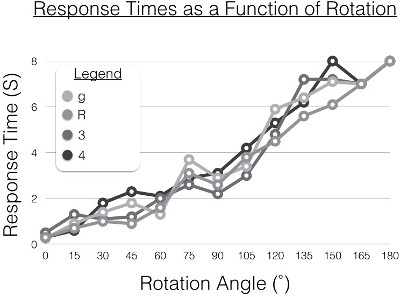心的回転
概要
ソース: ジョナサン ・ Flombaum 講座-ジョンズ ・ ホプキンス大学
視覚的な精神的なイメージは、心の目のイメージを想起させる能力を指します。これにより、現在の視点; の制約を超えてビジュアル素材を処理する人たとえば、彼らの心の目、何かがどのように異なる色にまたは別の材料から行われたかのようになりますを使用または回転し、別の視点から見た、人が想像できます。精神的なイメージは、多くのコンテキストで重要な人間の行動をサポートするようです。たとえば、ルートを計画するときのルートとマップの可視化や指示を与える人々 をレポートします。彼らは実際の行動の準備に、バットを振るなどの動きを可視化を報告します。彼らはまた、オブジェクト可能性があります容器に収まるまたはバリアをオフに方法を考慮するためにオブジェクトの心的回転を報告します。
このビデオは、視覚的な精神的なイメージを調査するために精神的な回転操作を使用する方法を示します。
手順
個人が視覚心像に依存する必要があります-心の目のイメージを想起させる能力-を正確に世界を認識し、行動を案内します。
たとえば、特定の場所や家の場合それが改造されたようになりますへのアクセスを計画するときは、ルートを視覚化する精神的なイメージが使用されます。
実験心理学者は、おなじみの文字の回転バージョンを特定し、その鏡像の回転バージョンからそれらを区別する心的回転のパラダイムを使用して、人の視覚心像を測定できます。
心的回転プロシージャを使用して、このビデオ デモンストレーションを分析および視覚心像を調査して結果を解釈する方法と同様に、どのように刺激を設計し、実験を行います。
この実験では、参加者に刺激を提示、後続刺激が元のアイテムのまたはそのミラー イメージの回転かどうかを区別するために尋ねた。
この場合、タスクの刺激は、R、g、4 と 7、ヘルベチカ ライト フォントで印刷したすべてのような数字などの文字で構成されます。
結果
申請書と概要
タグ
スキップ先...
このコレクションのビデオ:

Now Playing
心的回転
Cognitive Psychology
13.1K 閲覧数

聴テ
Cognitive Psychology
26.4K 閲覧数

減算の反応時間とドンダースの測定
Cognitive Psychology
44.2K 閲覧数

機能や接続詞の視覚探索
Cognitive Psychology
26.8K 閲覧数

認知心理学の視点
Cognitive Psychology
6.9K 閲覧数

両眼視野闘争
Cognitive Psychology
7.9K 閲覧数

複数物体追跡
Cognitive Psychology
7.6K 閲覧数

おおよその感覚テスト
Cognitive Psychology
7.5K 閲覧数

プロスペクト理論
Cognitive Psychology
11.2K 閲覧数

言語的作動記憶容量を測定
Cognitive Psychology
12.4K 閲覧数

視覚ワーキング メモリ遅延推定精度
Cognitive Psychology
5.2K 閲覧数

ことばによるプライミング
Cognitive Psychology
14.9K 閲覧数

付随のエンコーディング
Cognitive Psychology
8.4K 閲覧数

統計学習
Cognitive Psychology
7.0K 閲覧数

鏡映描写の運動学習
Cognitive Psychology
55.4K 閲覧数
Copyright © 2023 MyJoVE Corporation. All rights reserved
